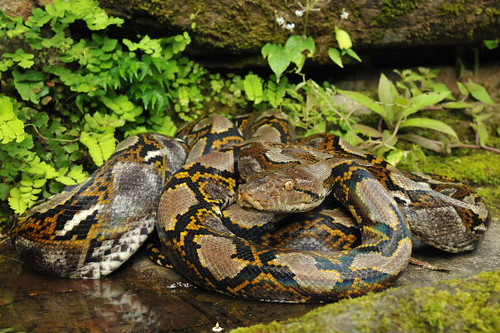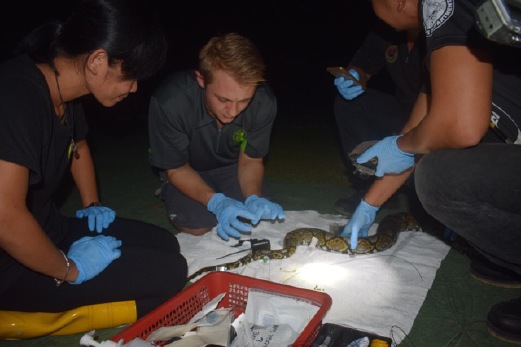Probable prey animal mobbing of a small(~2m) reticulated python, with mentions of a defensive balling posture on part of the snake
Report on the observed response of Javan lutungs (Trachypithecus
auratus mauritius) upon encountering a reticulated python (Python
reticulatus)AbstractWe observed an encounter between a reticulated
python (Python reticulatus) and a group of wild Javan
lutungs (Trachypithecus auratus mauritius) at the Pangandaran
Nature Reserve, West Java, Indonesia. A python
(about 2 m in length) moved toward a group of lutungs in
the trees. Upon seeing the python, an adult male and several
adult female lutungs began to emit alarm calls. As the
python approached, two adult and one sub-adult female
jumped onto a branch near the python and began mobbing
the python by shaking the branch. During the mobbing,
other individuals in the group (including an adult lutung
male) remained nearby but did not participate. The python
then rolled into a ball-like shape and stopped moving, at
which point the lutungs moved away. The total duration of
the encounter was about 40 min, during which time the
lutungs stopped feeding and grooming. Group cohesiveness
during and after the encounter was greater than that before
the encounter, indicating that lutungs adjust their daily
activity in response to potential predation risk.
"
Observation of the encounterOn September 11, 2015, two authors of this study (YT and
BP) observed the J group of lutungs at 0800 and began
tracking them. As of August 2015, the J group comprised
one adult male, five adult females, four juveniles, and one
infant (definition of the age class based on Brotoisworo
1991). At 1300 on September 11, members of the J group
fed on Swietenia macrophylla (Meliaceae) petioles and
moved to the border area of TWA and CA (108390
2100E, 7 4202700E; Fig. 1). They then rested on adjacent Syzygium
antisepticum (Myrtaceae) and Dysoxylum caulostachyum
(Meliaceae) trees with branches extending over an adjacent
stream. At 1329, continuous ‘‘Geko Geko’’ and ‘‘Kuek
Kuek’’ alarm calls emitted by the alpha male (name: PIR)
and several females were heard, as well as sounds of
branches shaking. The vocalization ‘‘Geko Geko’’ (noted
as a ‘‘harsh bark’’ in Brotoisworo (1991), Online Resource
1) is usually emitted when a potential predator (such as
feral dogs) and neighboring groups of lutungs are nearby.
The vocalization ‘‘Kuek Kuek’’ (Online Resource 2),
thought to be emitted by females, is similar to that emitted
when a group encounter occurs, and is higher-pitched.
Initially, it was assumed that a neighboring lutung group
was approaching; however, at 1340, we observed a reticulated
python (estimated length: 2 m; body width:\10 cm;
sex: unknown) in the S. antisepticum tree in which part of
the lutung group were located. The python then moved
toward the lutung group, at which time PIR emitted the
‘‘Geko Geko’’ call four times and the adult females emitted
the ‘‘Kuek Kuek’’ call three times, finishing at 1350. It was
verified that the alarm calls were indeed emitted after the
lutungs spotted the python. The branch of the S. antisepticum
shook several times, but the types of interactions that
occurred could not be observed due to foliage cover. At
1351, the python started moving from the S. antisepticum
tree toward the D. caulostachyum tree that contained the
remaining lutungs. At 1353, PIR emitted the ‘‘Geko Geko’’
call again, and at 1355, a sub-adult female (BAG) emitted
‘‘Kyat’’ sounds, which are thought to represent fear or
vigilance. At 1356, an adult female (PEP) jumped at a
branch about 2 m away from the python and mobbed the
python by shaking the branch. PEP then emitted ‘‘Kyat’’
sounds and jumped back to her original position. Three
adult females (HIU, GON, and BAG) surrounded PEP and
the python, while four other lutungs remained close
(\10 m) but did not join the interaction. PIR, who had first
emitted the ‘‘Geko Geko’’ call, was now asleep. By 1400,
the area had become silent, with no movement by either the
python or the lutungs. At 1403, BAG moved toward the
python, but did not approach any closer than 5 m. At 1400,
the lutungs began moving toward the west, and when they
were almost 20 m away, they stopped for 10 min before
continuing westward. At 1405, the python rolled into a
ball-like shape on the D. caulostachyum tree branch, and
stopped moving (Fig. 2b); the encounter and associated
interactions seemed to have ended. At 1412, PIR emitted
the ‘‘Geko Geko’’ call again, but it was unclear whether
this was intended as an alarm. The lutung group was followed
until 1700, after which we decided to return to the
place where the encounter had occurred, where we found
that the python had not moved. On September 12, the
location was revisited at 1157, at which time the python
was no longer in the tree.
To address the effects of this encounter on the behavior
of the lutungs, we compared activity budgets across three
phases: before (0700–1328), during (1329–1428), and after
(1429–1700) the encounter. This comparison showed significant
differences among the three phases (Chi-square
test of independence: v2 = 26.9, df = 6, p\0.001; we
merged grooming and alarm calls as ‘‘social behavior’’).
Residual analysis showed that the percentage of feeding
was lower and the percentage of resting was higher during
the encounter, and this relationship reversed after the
encounter (p\0.05 for each; Fig. 3a). The number of
animals per scan, an indication of group cohesiveness, also
varied significantly among the three phases (Kruskal–
Wallis test: v2 = 14.9, df = 2, p\0.001), and the number
of scanned animals was significantly larger during and after
the encounter (Steel–Dwass tests: p\0.05 for each;
Fig. 3b)."
link to initial report














